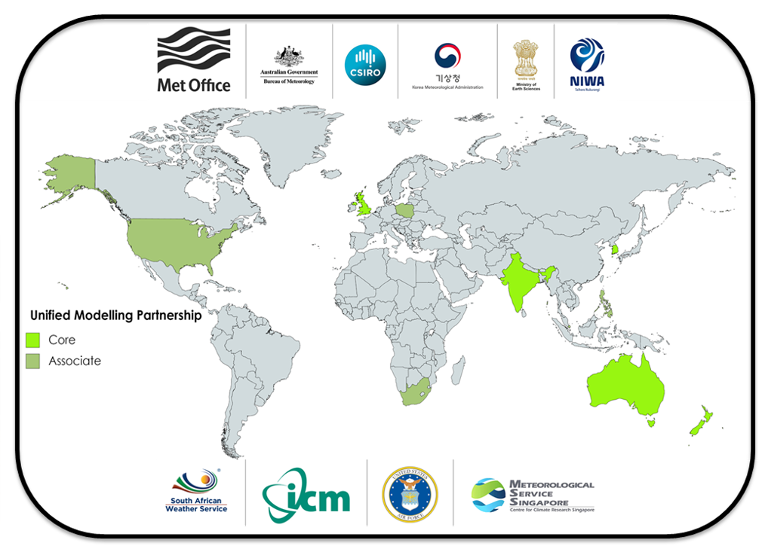Unified Model Partnership
The UM Partnership consists of operational and research centres that use and develop the UM.
Aims and benefits
The Unified Model is a suite of earth system modelling software used for weather and climate modelling applications. The UM Partnership enables scientific and technical collaboration on a shared modelling system, across a range of modelling and science issues relevant for weather and climate prediction. Working together reduces the cost and increases efficiency of the development through shared scientific and technical knowledge and development. It leverages science and technical effort beyond that possible from a single organisation.
"If you look at our numerical weather prediction performance, you can see a very distinct step change in the reliability of our warnings. For instance, when there was severe flooding in Victoria, warnings were issued five days in advance - a timeframe that would only have been dreamt of ten years before." Peter May, Assistant Director of Research & Development at the Bureau of MeteorologyEarly successes
Built on a number of operational centres using the UM in 2008, the first priority for the UM Partnership agreed in 2014 was to develop a common technical infrastructure, allowing scientists and software engineers to use common development tools. One new tool built to run and monitor complex modelling suites is Cylc, originally developed at NIWA, now an Open Source collaboration involving NIWA, Met Office, and others. Rose is another tool aimed at making it easier for users to build, run and manage complex suites across the partnership.
Technical infrastructure was further improved in 2015 with the launch of a cloud based repository service, providing access to the full code available as part of the UM suite of software, and allowing scientists to develop branches on the same repository.
The focus of the Joint UM Partner Science Programme (JUMPS) is on model evaluation and development activities at global and regional scales. Recent contributions from partners include:
- Assessment of global science configurations GA7 and GC3 over the Maritime Continent and East Asia, and performance from medium-range to climate timescales
- Assessment of prototype regional science configurations RA1-M and RA1-T with case studies and trials over several domains around the globe
Structure
Core and Associate Partners use the UM for operational weather forecasts and climate modelling. They contribute financially and with dedicated human resources to the partnership. The amount of commitment and influence differs between Core and Associate Partners. In addition there are a range of Research Partners in the UK and in our partner countries, which are not involved in real-time operational services. They contribute in various ways to the quality of the UM by using, testing and developing the model for their research activities.
Core Partners
- Bureau of Meteorology / CSIRO (Australia)
- MoES / NCMRWF (India)
- NEA / MSS / CCRS (Singapore)
- NIWA (New Zealand)
- KMA (South Korea)
- Met Office (United Kingdom)
Associate Partners
- ICM (Poland)
- SAWS (South Africa)
- US Air Force (United States)

Governance
Strategic directions of the UM Partnership and shared activities are decided by the Core Partners in the UM Partnership Board. The Board manages the use of the UM Partnership fund, defines a joint science and technology programme and prioritises shared work. Associate partners are consulted regarding their needs and interests by the Board. A Technical Advisory Group leads the joint technical infrastructure and advises the UM Partnership Board.
Activities
Research and development programmes
The UM Partnership aims to develop the UM in a directed and structured way. Coordinated joint programmes provide the direction of the work undertaken by the UM Partnership. Additional strategic investment projects are used to concentrate resources on joint interests. Active science and technology programmes currently include:
- Technical infrastructure development with a focus on ancillary tools and suites, coordinated development of observation capability, and development of next generation infrastructure and tools for use in the LFRic framework
- Coordinated model evaluation and development programmes delivering consistent science packages for global and regional modelling around the globe, with a focus on Southern Ocean and tropical performance, and the representation and simulation of convection
In addition to the shared work agreed within the UM Partnership, partner organisations carry out independent research and development. Output from these programmes are shared within the Partnership where possible and help to build common capabilities.
"Forging UM partnerships with other national weather services is proving to be of considerable benefit to the participating parties, and activities span the range from global to convective permitting modelling. MOSAC applauds the greater involvement of partners in model development. This in turn has demonstrated the complementary strength of the partner institutions and their contribution to pivotal aspects of the Met Office’s own research programme." Met Office Scientific Advisory GroupOperational numerical weather prediction (NWP)
Whilst some UM Partners are capable of running their own global UM for NWP, other have access to real-time datafeeds to drive downstream regional versions of the UM. This service requires partners to be either a national meteorological service or to have contracts with their government to carry out operational forecasting on their behalf.
Collaboration
The UM Partnership is facilitated by our science partnerships scientists, through community and relationship management, planning of science and technology, technical infrastructure development, model support and training activities. An annual model workshop, scientist exchanges and partner site visits are used to promote the shared work and to build a globally distributed research and development team. The UM Partnership team can be contacted via [email protected].






